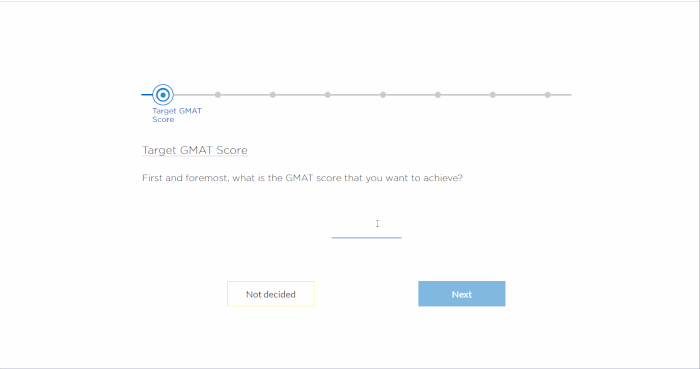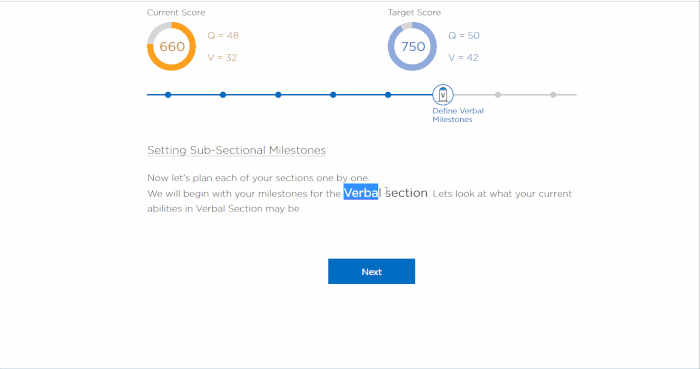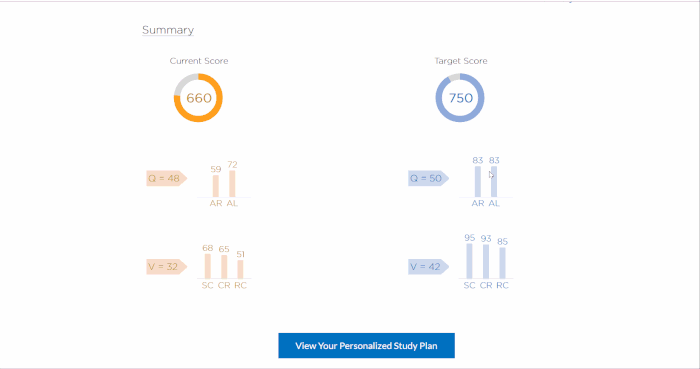In this article, we will demonstrate how you can create a personalized study plan to go from 660 to 750. This assumes you have a precise estimate of the starting scores either from your ESR or any mock test that you have taken. Even if your current and target scores are different you can follow this article to understand how to create your own plan.
This article is a part of a series of articles on creating personalized study plans for your GMAT preparation. In the first article of this series, you saw the importance of creating a Personalized Study Plan and the features of the Personalized Study Planner that makes it awesome! If you missed out on reading those, here are the links:
- Personalized Study Planner – GMAT Planning Made Easy (first article)
- Personalized Study Plan Using PSP – From GMAT 590 to GMAT 710 (second article)
The second article in the series above will help you in case you do not have a precise estimate of your starting scores.
Steps to create a Personalized Study Plan in less than 5 minutes
Personalized Study Planner gives you the plan in three broad stages. It will first give you an initial estimate of the GMAT date based on your current and target scores. In the next stage, you will get personalized milestones for every sub-section that GMAT tests you on. Your execution of the plan should be around reaching those milestones before actually taking the test. This milestone-driven plan and execution will double your chances to reach your target score in 25% fewer hours!
Let’s get started with the plan.
Step 1- Get an Initial Estimate of your probable GMAT Date

In this stage, the tool will give you an initial estimate of your probable GMAT date. The tool takes into account your current scores (Total, Quant, and Verbal) and total target score to recommend a combination of Q and V scores to reach that target score. This suggested combination leverages your strength as understood from your current scores. This is also the stage in which you select the path you will follow to reach your target score – whether it will be Quant driven or Verbal driven. Here is one example to show you what we mean.
Anupriya achieved a GMAT score of 760 with a Q48 and a V46 by leveraging the Verbal section. While Dhananjaya scored a 760 on the GMAT with a Q50 and a V42 by leveraging Quant section.
| Total | Quant | Verbal | |
| Current Scores | 660 | 48 | 32 |
| Target Scores | 750 | 50 | 42 |
Estimated GMAT Test Date
Based on your inputs so far, the system suggests the week by which you would have likely completed your preparation. The underlying assumptions for this date are:
- You will start your preparations the next day onwards
- You will spend 20 hours per week on preparation
- You will use an online course that will help you track your preparation correctly
This is an initial estimate based on your inputs so far. A final estimate, which is more precise, is then created in the next stage based on the individual sub-sections current and target abilities.
Tip #1: You must make sure that you select your target score carefully. A good target score would be the median score of your desired program. If you are looking at getting scholarships, you must target around 30 points higher than the median score. In this example, we would take a target score of 750. Check FAQ #3 on this screen to find out the median scores of the schools* or read this article outlining the median scores of top business schools in the US and Europe.
Step 2 – Determine the Milestones that lead to your Target Score

In this stage, you would determine the milestones that will lead to your target Quant and Verbal scores. The current scores that you will enter for Quant and Verbal sub-sections would be used to suggest a recommended path (milestones in each sub-section). You can either accept it or modify it. The tool would also show you an estimate of the time that you would need to reach those milestones given your current and target sub-sectional scores.
| Verbal | Quant | ||||
| SC (%ile) | CR (%ile) | RC (%ile) | AR (%ile) | ALG (%ile) | |
| Current Scores | 68 | 65 | 51 | 59 | 72 |
| Target Scores | 95 | 93 | 85 | 83 | 83 |
Tip #2: Use the Lock option next to sub-sectional scores while modifying scores to set more than 1 Verbal sub-sectional scores. This will help you input precise values in the system.
Step 3 – Get your Personalized Study Plan

In this stage, you customize the plan to suit yourself. The aspects that you will finalize in this section are:
- Sequence of Study
- A realistic amount of time you can devote on a daily basis and the corresponding estimate of GMAT date
- If you have a GMAT test in mind you can adjust the amount of time you can spend daily to complete your prep in the given time.
In the high-level view, you can also see how your score will move as you keep building your abilities to reach set milestones.
Sequence of Study
We recommend studying one section (either Verbal or Quant) at a time and starting with your stronger section. Starting with the stronger section build the much-needed confidence and momentum to your GMAT preparation. However, you get an option to change the sequence to suit yourself.
You also get a chance to change the amount of time you will spend on weekdays and weekends based on your schedule. The calendar can be personalized to the day. If you have prior commitments on a particular day, you can change the number of hours for that particular day by clicking on it.
Daily Study Time
You must create your plan based on the realistic amount of time you can spend. You must not be too ambitious or too conservative while setting daily time. Based on your daily time estimate for study, you will get a calendar and a better estimate of your likely GMAT date. In case you have a GMAT Date in mind, you can increase or decrease your daily time to complete your preparation by that time.
Tip #3- You can change study hours for a particular day by clicking on that day. You can, therefore, account for no-study days or days where you can study more than you do on other days.
Summary
Now that you have gone through the steps to create the Personalized Study Plan, let’s quickly look at the best practices and summarize things you need to keep in mind while creating the plan.
- Know the scores required to get into your target programs. Aim for 30 points higher than the median score of your target programs.
- Make sure you adjust your current scores either using your ESR/mock test reports or your comfort level to ensure that you get a personalized plan.
- Take note of MILESTONES (target abilities or percentiles) that you finalize in the plan. This should be the most important aspect of the Study Plan that you take away. Achieving this number should be the deciding factor for you to move on to the next sub-section or call your prep in one sub-section complete.
- Milestones based approach in execution can double your chances to reach your target score!
PLAN. EXECUTE. ACE.
P.S. You can write to us at acethegmat@e-gmat.com with your questions.















